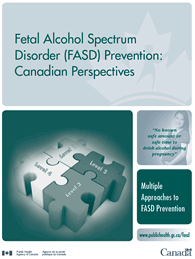In developing a panel presentation at the FASD International conference in 2007, Nancy Poole highlighted why the traditional “primary, secondary, and tertiary” model used for disease prevention did not fit as well for prevention of FASD. While designing that panel together with service providers and a birth mother to a child diagnosed with FASD, it dawned on Nancy and the panelists that FASD prevention wasn’t just about alcohol or pregnancy.
 When asked to prepare a write-up of this emerging thinking for the Public Health Agency of Canada (PHAC), Poole assembled a group of 25 Canadian prevention specialists to collectively discuss and build the final 4 part model. It was published by PHAC in 2008 (see page 18 for the list of 25 co-developers – Full MODEL Here). The model illustrates how it is important to link mother child and community health in prevention, including continuing to support women and children past the perinatal period.
When asked to prepare a write-up of this emerging thinking for the Public Health Agency of Canada (PHAC), Poole assembled a group of 25 Canadian prevention specialists to collectively discuss and build the final 4 part model. It was published by PHAC in 2008 (see page 18 for the list of 25 co-developers – Full MODEL Here). The model illustrates how it is important to link mother child and community health in prevention, including continuing to support women and children past the perinatal period.
Over these last 10 years, this Canadian model has been adopted or built upon by FASD prevention specialists in Canada and a number of countries.

A recent article discussing what to do about high levels of alcohol use during pregnancy in the United Kingdom recommended the 4-level prevention model as a way to help women make informed decisions.
In Australia, Dr. James Fitzpatrick of Telethon Kids has used and built upon the multi-level model by showing how important it is to link, intervention, research and diagnosis to FASD prevention efforts (Figure 2). He has led community-based FASD prevention initiatives in remote parts of Western Australia that have significantly reduced alcohol use during pregnancy.

Perhaps the model has influenced recent action plans regarding FASD, such as that of New Zealand. It emphasises the need for wrap-around services that pair women’s and children’s health including substance use services and treatment for pregnant and post-partum women. They also emphasize collaboration across sectors at the policy and community level.
Looking back, the 4-level prevention model was developed from the collective wisdom of researchers, service providers, policy analysts and birth mothers while implementing prevention initiatives in Canada. Further adaptations have included larger policy components that are key to prevention of alcohol problems. The development process of the model underscores how no one agency or approach can cover FASD prevention. It requires efforts in each of the levels, in ways that are mutually reinforcing.
For more resources and topic discussions on the prevention of FASD, please click here.


